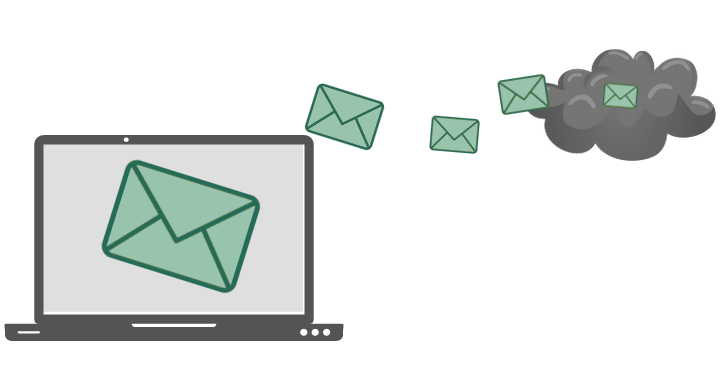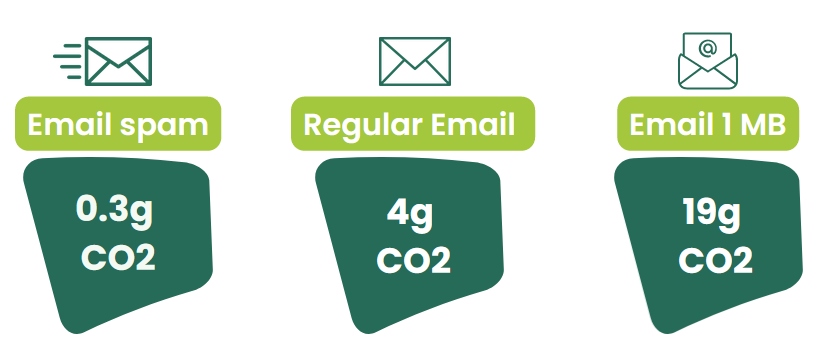You sent an email instead of making a phone call because you didn’t have the time, you wrote to your colleague to see if he was attending the meeting instead of getting up from your desk and asking him directly. Or you wanted to put down in writing what was said in the last call for you to ‘stay’.
These are all ‘legitimate’ actions that everyone does every day without thinking about it. Yeah, but have you ever thought about how much an e-mail pollutes? Much more than you think, as we will discover in this article.

How much does an e-mail pollute? By the numbers
All e-mails pollute more than a little. According to Ademe, the French Environment and Energy Management Agency, a 1 megabyte e-mail emits around 19 grams of CO2.
In itself, this does not seem like a big number, but try to think bigger. Imagine a company with 50 employees where everyone sends 5 e-mails a day, 5 days a week. In one day, each of them produces 95 grams of CO2, which, multiplied by 50, makes a whopping 4750 grams of CO2! If we multiply this number by 5, as many as there are working days in this company (not counting weekends), we arrive at 23750 grams of CO2, i.e. more than 23 tonnes!
To understand this better: if a car produces about 150 grams of CO2 per km, it is like saying that 5 e-mails per day sent by 50 employees in a working week are equivalent to almost a car journey from Milan to Reggio Emilia (which are 154 km away).
What does this mean? That while we ‘easily’ perceive how much a car pollutes and, if we wish, we can choose sustainable forms of mobility such as train or carpooling, we are hardly aware of how much an e-mail pollutes.
In fact, we use it very often and for everything even when it would suffice, as we said before, to go and talk directly to a colleague or make a short phone call. Just as one could use the cloud to exchange files and information.
IIn the corporate world, moreover, this is no surprise: email is the second most used channel to share content with colleagues about the company, the sector, etc.: according to the Demand Gen Report, 70% of professionals do so.
But the email method is not just a communication tool between people: according to the Content Marketing Institute, 87% of B2B marketers use email as a distribution channel.

Why does email pollute?
The pollution of e-mail is due to the fact that in sending an email there is the energy consumption of the computer together with that of the servers that help get the message to its destination.
As we know, servers, by themselves, consume a considerable amount of electricity not only to be powered but for their cooling system. This is why it makes a big difference whether you send a 1 megabyte or a 10 megabyte e-mail: the amount of energy servers need to run and cool themselves is undoubtedly greater.
E-mail is therefore an example of a digital footprint that has an effect on the environment.
How to reduce the environmental impact of your mail

It is true: we can choose servers that use renewable energy – and that would not be a bad idea at all – but beyond that there are good actions that each of us can do to reduce the pollution of email.
Here are some practical tips that you can apply today:
1. Ask yourself whether it is really necessary to send that e-mail
Before sending an email, ask yourself whether you can get your message across in a different way. For example: can you call the person and discuss it over a phone call ? Or could it be more fruitful to arrange a meeting? Opting for one or the other solution could reduce the number of emails considerably: just one is enough to organize when you will meet with that person or to ask him/her when you can get in touch.
Again: are you going to meet a colleague soon? If so, is it really necessary for you to write to him/her while on the metro, perhaps from your mobile phone? If it’s nothing urgent – and if it is, maybe a call is better – wait until you see him to confront him in person.
2. Compress attachments and use the cloud
Are you about to send an email with a 10 mega attachment? Try reducing it: there are many free tools online to compress pdfs, images, power points and whatnot.
Or use the cloud: this way you will avoid sending and receiving mails all the time to find out about changes. You will just get a notification when the person has introduced some change. Moreover, you can view the document at any time without the need for someone to notify you by email.
3. Unsubscribe from newsletters you are not interested in
We all do it: we subscribe to newsletters thinking that we will read them but this often does not happen. So do a scan of all those emails you have received and never opened: if it has been months or even years, it means you are not interested! In this case, go to the ad hoc button and unsubscribe. The environment will thank you.
4. Delete useless emails
Cleaning out your e-mails is important. There are some people who leave emails in their inbox that date back 5 or 10 years. Unless it is for a particular reason – in which case it is better to save it elsewhere because you never know – delete old mails. Also, constantly empty the recycle bin.
5. Avoid copying everyone when sending an email
Last but not least: avoid, when sending a business email, copying people who are not directly interested in the conversation. Often people who are in CC tend not to read those mails so you will only burden their inbox and use even more servers. Send the emails to the people who are really involved in what you are saying, the others, rather, update them from time to time without clogging up their mail.
Can you think of any other tips?
Read also..





